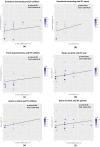Basic taste sensitivity, eating behaviour, food propensity and BMI of preadolescent children: How are they related?
- PMID: 38433733
- PMCID: PMC10904958
- DOI: 10.12688/openreseurope.14117.3
Basic taste sensitivity, eating behaviour, food propensity and BMI of preadolescent children: How are they related?
Abstract
Background: Taste sensitivity has been reported to influence children's eating behaviour and contribute to their food preferences and intake. This study aimed to investigate the associations between taste sensitivity, eating behaviour, food frequency and BMI (Body Mass Index) in preadolescents.
Methods: Preadolescents' taste sensitivity was measured by detection threshold of sweetness (sucrose), sourness (citric acid), saltiness (sodium chloride), bitterness (caffeine, quinine), and umami (monosodium glutamate). In addition, the Child Eating Behaviour Questionnaire (CEBQ), the Food Propensity Questionnaire (FPQ) measuring food frequency, and the children's body weight and height were completed by the parents. A total of 69 child-parent dyads participated (preadolescents mean age =10.9 years).
Results: Taste sensitivity to caffeine bitterness was significantly associated with eating behaviour in food responsiveness, emotional overeating, and desire to drink. The preadolescents who were less sensitive to caffeine bitterness had higher food responsiveness scores. Those who were less sensitive to caffeine bitterness and to sweetness had higher emotional overeating scores. In addition, preadolescents who were less sensitive to sourness and bitterness of both caffeine and quinine demonstrated to have higher scores in desire to drink. There was no association between taste sensitivity and FPQ, but significant differences were observed across preadolescents' BMI for FPQ of dairy food items, indicating higher consumption of low-fat milk in the overweight/obese compared to the underweight/normal-weight subjects. There was no significant difference in taste sensitivity according to BMI. Preadolescents' eating behaviour differed across BMI, demonstrating a positive association between BMI and food approach, and a negative association between BMI and food avoidance.
Conclusions: This study contributes to the preliminary understanding of the relationships between taste sensitivity and eating behaviour in preadolescents. The results may be used to develop effective strategies to promote healthy eating practices by considering taste sensitivity in preadolescents.
Keywords: BMI; Basic tastes; Dairy foods; Detection threshold; Eating behaviour; Food propensity; Preadolescents.
Copyright: © 2024 Ervina E et al.
Conflict of interest statement
No competing interests were disclosed.
Figures


Similar articles
-
Investigating the Relationships between Basic Tastes Sensitivities, Fattiness Sensitivity, and Food Liking in 11-Year-Old Children.Foods. 2020 Sep 18;9(9):1315. doi: 10.3390/foods9091315. Foods. 2020. PMID: 32961966 Free PMC article.
-
Does Responsiveness to Basic Tastes Influence Preadolescents' Food Liking? Investigating Taste Responsiveness Segment on Bitter-Sour-Sweet and Salty-Umami Model Food Samples.Nutrients. 2021 Aug 7;13(8):2721. doi: 10.3390/nu13082721. Nutrients. 2021. PMID: 34444881 Free PMC article. Clinical Trial.
-
Preliminary Exploration of Obesity-Related Eating Behaviour Patterns in a Sample of Saudi Preschoolers Aged 2-6 Years through the Children's Eating Behaviour Questionnaire.Nutrients. 2021 Nov 20;13(11):4156. doi: 10.3390/nu13114156. Nutrients. 2021. PMID: 34836411 Free PMC article.
-
The sweetness and bitterness of childhood: Insights from basic research on taste preferences.Physiol Behav. 2015 Dec 1;152(Pt B):502-7. doi: 10.1016/j.physbeh.2015.05.015. Epub 2015 May 20. Physiol Behav. 2015. PMID: 26002822 Free PMC article. Review.
-
[Simple obesity in children. A study on the role of nutritional factors].Med Wieku Rozwoj. 2006 Jan-Mar;10(1):3-191. Med Wieku Rozwoj. 2006. PMID: 16733288 Review. Polish.
Cited by
-
Investigating the Relationships between Taste Preferences and Beverage Intake in Preadolescents.Foods. 2023 Apr 14;12(8):1641. doi: 10.3390/foods12081641. Foods. 2023. PMID: 37107436 Free PMC article.
-
Variations in basic taste perception and body mass index.J Diabetes Metab Disord. 2025 May 18;24(1):122. doi: 10.1007/s40200-025-01628-2. eCollection 2025 Jun. J Diabetes Metab Disord. 2025. PMID: 40395402
References
-
- Ahrens W, on behalf of the IDEFICS consortium: Sensory taste preferences and taste sensitivity and the association of unhealthy food patterns with overweight and obesity in primary school children in Europe—a synthesis of data from the IDEFICS study. Flavour. 2015;4(1): 8. 10.1186/2044-7248-4-8 - DOI
-
- Alexy U, Schaefer A, Sailer O, et al. : Sensory Preferences and Discrimination Ability of Children in Relation to Their Body Weight Status. J Sens Stud. 2011;26(6):409–412. 10.1111/j.1745-459X.2011.00358.x - DOI
LinkOut - more resources
Full Text Sources
